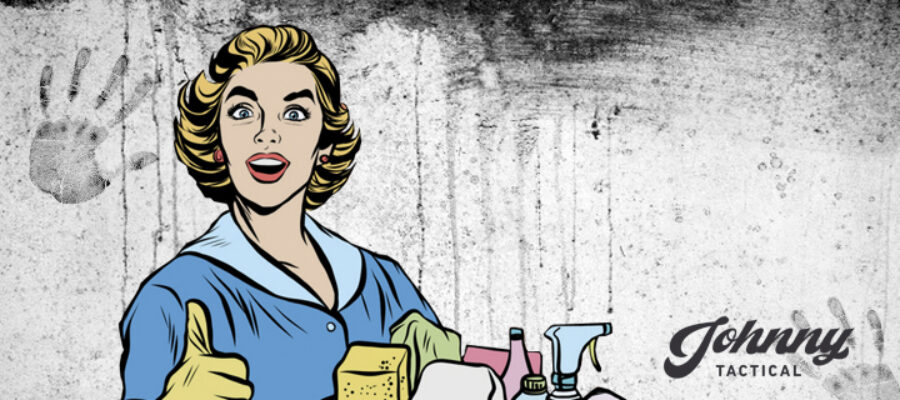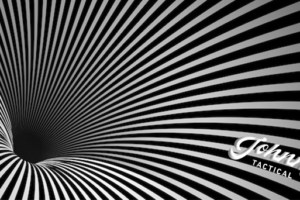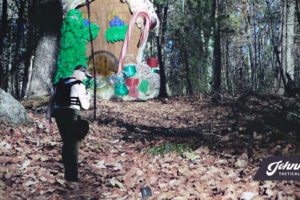We were completely exposed and they were armed to the teeth. It was another great start to the midnight shift.
After driving Code 3 from one side of the city to the other my trainee and I found ourselves in the middle of a gravel parking lot next to a Little League baseball field. All we knew at that point was that someone had called 911, there was mixed information of either a shooting, a stabbing, or both, that everyone involved was somewhere in the woods behind the baseball field.
We took up a position in that parking lot because there was a trailhead that connected those woods with that lot. The trail led down from a steep, rocky incline that was heavily wooded giving them cover and the high ground. If the suspects were up there and armed we were in a bad spot. There was no place we could go for cover and still be able to secure that area. Distance and our spotlights were our only friends.
Good News
It wasn’t long before four men emerged from the trail where the woods met the back of the baseball diamond about 100 yards in front of us. They wore camouflage, exterior ballistic vests loaded with magazines, and carried rifles and sidearms. I didn’t know what to expect when we rolled up but four fully armed modern day mercenaries were not on my list of potentialities.
The good news was that they were all compliant, but we still had to manage them safely and securely. The terrain, the lack of cover, the limited number of officers (there were three of us now and one trainee in his first week which is really like a minus one), and the potential for violence created a unique problem to solve. And so, we started to break it down by eliminating variables.
Except One
We had one officer maintain cover from distance on the GI Joes standing at the wood line, one officer direct them back to us one at a time, and one officer secure them, search them, and sit them down behind a cruiser. It was a slow process, but it was the only way to keep us safe, thoroughly search and secure each one, and begin to sort out just what in the Sam Hill was going on around here.
As we dealt with each person by calling them back and searching them, we found that the guns they carried were all Airsoft guns — except one. One of them carried a real live loaded pistol mixed in with their Airsoft gear and most of them carried a knife. The methodical search of each person and the Clean Wall, Dirty Wall system was critical in keeping both us and them safe.
The System
One major problem when dealing with both multiple officers and multiple suspects is the high potential for someone or something to get missed or to assume that a search has been done, when it hasn’t. When there is a lot going on and a lot of moving parts it’s very easy for confusion to set it or for assumptions to be made. The best way to mitigate that is by using a system.
The Clean Wall, Dirty Wall concept is pretty straight forward, easy to implement, and creates a systematic process of elimination that will keep you and your partners safe. The idea is that as you encounter multiple people (often times you don’t know who is a suspect and who is not) you establish a “dirty wall” and a “clean wall,” which are two distinct and separate areas for triaging the people you encounter at a scene. Any to avoid any further confusion, this has nothing to do with hygiene.
Everyone starts out as “dirty,” meaning they have not been searched or identified, and they remain dirty until they have been “cleaned.” When first encountered they will be directed to the dirty wall, which could be a room, a particular piece of cover, or a cruiser that has already been cleared and secured. They are handcuffed, thoroughly searched, and identified before being moved to the “clean wall.” The clean wall could be the opposite side of a room, another cruiser, or any designated area that is obviously separate and distinct from the dirty wall. By establishing these two areas you create an assembly line of sorts, that you systematically move people through so no one and no weapon gets missed.
Assumptions
We know from studying active shooting scenarios at schools, businesses, and the like that suspects who don’t kill themselves can and will try to pass themselves off as one of the crowd, slip through the dragnet, and elude capture. Plus, whether it be a shooting or stabbing at a night club, bar, or a complete Charlie Foxtrot in the woods somewhere, you cannot assume who is the bad guy and who is not. Everyone must be treated as dirty until proven otherwise and the best way to do that is through a systematic approach like Clean Wall, Dirty Wall.
You can implement it without any formality and without any supervisors (supervisors, shmoopervisors). It can be impromptu and on the fly. All you need is for the men and women you are working with to be on the same page, and two safe areas to use for the clean wall and the dirty wall. Don’t miss the fact that they must be in a safe area — an area that has been cleared of threats, is out of the line of fire, and is secured by at least one cover officer.
Everybody’s A Winner
Once you’ve established the area for your Clean Wall and Dirty Wall you can quickly and confidently move people through it to ensure everyone is safe and to keep the investigation moving. From the Clean Wall area people can be funneled to detectives for interviews, to medics for treatment, or to waiting parents.
Don’t allow a chaotic scene to dictate your tactics — or your lack thereof. Take control by eliminating variables through a systematic approach like the Clean Wall, Dirty Wall. It will help bring order out of chaos, increase your safety, and decease the possibility of missing a weapon or a bad guy. Do that, and everybody’s a winner.
__________________________
- How do you currently deal with chaotic scenes involving multiple people?
- Have you or a coworker ever missed a suspect or a weapon?
- What can you learn from that?
__________________________
Thanks for reading! Do you have a story that you think we could learn from and that you’d like to share with Johnny Tactical nation? Fill out the contact form and include your name, rank, and department, or email it to [email protected] and follow these guidelines:
– It must be a firsthand account
– True
– Have a lesson, principle, or tactic to apply
– Cleaned of names, dates, and places
– Include your call sign
If your story is selected and published in our blog you’ll get the credit using your call sign and we’ll send you a free Johnny Tactical morale patch.






Leave a Reply
Your email is safe with us.
You must be logged in to post a comment.